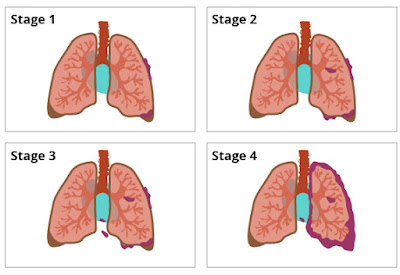The four stages of mesothelioma allow doctors to identify and classify the severity and progression of the cancer at diagnosis. Stage 1 offers the most hopeful prognosis, while a Stage 4 diagnosis often means the patient is limited to palliative care.
How Mesothelioma Is Staged
Mesothelioma staging refers to the process of categorizing mesothelioma according to the extent of the disease in a patient’s body. Staging is actually a process common to all types of cancer, although specific staging systems are often developed based on characteristics of specific cancers, like mesothelioma.
Staging only occurs at diagnosis. While the cancer may progress or recede, the stage of mesothelioma at diagnosis will not change. For example, if a Stage 1 mesothelioma tumor spreads to other parts of the body, it is called Stage 1 with metastasis. Likewise, if a Stage 4 mesothelioma tumor reduces in size or goes into remission, the stage will not change. While the initial treatment program may depend on the mesothelioma stage, actual treatment may vary depending on how the disease progresses.Generally, staging requires a number of diagnostic tests to determine the tumor location, size, and whether it has spread beyond the initial site.
Mesothelioma Staging by Type
Given the rarity of mesothelioma, a formal staging classification exists only for pleural mesothelioma, the most common variety. No formal staging systems are defined for peritoneal, pericardial, or testicular mesothelioma.Although there are no staging systems for less common forms of mesothelioma, the American Joint Committee on Cancer (AJCC) has published general guidelines for staging cancer in its AJCC Cancer Staging Manual. Therefore, even when doctors do not have guidelines for a specific form of cancer, they can still refer to the general guidelines to help determine the stages of extremely rare cancers like peritoneal mesothelioma and pericardial mesothelioma.
Stages of Mesothelioma
The four stages of mesothelioma vary slightly within each system, but they can be generalized as indicated below. Please click into the individual pages to get more information about each stage.Stage 1
In Stage 1, the mesothelioma tumor is in one location, and the cancer has not spread to lymph nodes or other organs or tissues. In general, surgery may be an option for removing the tumor.Stage 2
In Stage 2, the mesothelioma tumor is larger and has invaded nearby organs, such as the lung or diaphragm. Lymph nodes may also be involved. In this case, surgical resection may still be possible, though more difficult depending on the extent of the growth.Stage 3
In Stage 3, mesothelioma has invaded a region or area, such as the chest wall, esophagus, or lymph nodes. Surgery is generally not an option as a curative treatment, though other treatments may be tried.Stage 4
In Stage 4, the mesothelioma has spread to multiple areas, such as other organs and tissues throughout the body. Surgery is not an option, and most treatments at this stage focus on reducing pain and discomfort.Pleural Mesothelioma Staging Systems
Over the years, different systems have been developed to stage mesothelioma. The three most commonly used systems are very similar, although they vary slightly. Learn more about each staging system for mesothelioma by selecting the appropriate link below.Note that mesothelioma-specific staging systems only exist for pleural mesothelioma. Other types of mesothelioma do not have their own staging systems.
Butchart Staging System
The Butchart staging system is the oldest and most commonly used staging system for mesothelioma. This system focuses on defining the location of the primary tumor mass in the body for each stage. The system doesn’t address how many cancer cells are present, how big the tumor is, or the overall amount of cancer present in the body.TNM Staging System
The TNM Staging System, developed by the American Joint Committee on Cancer (AJCC), is a staging system used for many different types of cancer. The current version of the TNM Staging System is detailed in the AJCC Cancer Staging Manual (7th ed., 2009). It considers the characteristics of the tumor (T), involvement of the lymph nodes (N), and whether the cancer has metastasized (M) to other locations within the body.Brigham Staging System
The Brigham Staging System also has four stages of progression. The primary difference of the Brigham System from the others is that, in addition to identifying tumor characteristics and metastasis, the Brigham System assesses the likely success of surgical intervention at each stage.Mesothelioma Stages Are Guides – Not Rules!
Although the stage of the mesothelioma can provide guidance about the expected course of the disease (that is, the prognosis) it isimportant to remember that the staging systems themselves are guides. At every stage, mesothelioma can be deadly – but there can also be some hope as well, no matter what stage you are diagnosed at.
to remember that the staging systems themselves are guides. At every stage, mesothelioma can be deadly – but there can also be some hope as well, no matter what stage you are diagnosed at.Every patient’s treatment options will depend heavily not only on the stage of the disease, but on the cell type and location of the mesothelioma they have, as well as the patient’s age, gender, and overall health.











